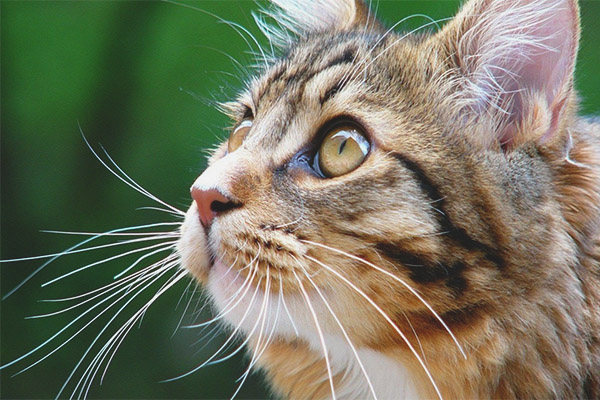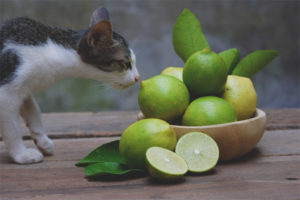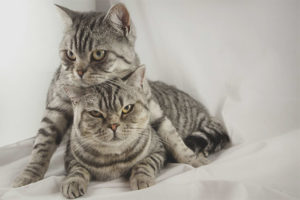The content of the article
Probably every owner at least once with curiosity considered the muzzle of his pet, wondering why cats need a mustache? This question is really interesting, because the cat's mustache is not just a kind of wool hair or a beautiful appendage of appearance. This is an important sense organ of cats, without which they would not be so nimble and playful as we know them.
What kind of education is this, is it dangerous to drop a mustache, can they be removed - these and other questions are answered in the article.
What does a cat have a mustache for?
Specific hairs in the area of the nose on the muzzles of cats are scientifically called vibrissae. If you look at the Latin roots of the word, it means "hesitate, shake." Vibrissae are hair shoots originating from the sensitive nerve endings on the cat's face. The hairs grow by 5-8 cm, have a thickened structure, bend poorly and never curl.They serve to capture the vibrations of air, touch, temperature and odors, thanks to which cats:
- perfectly oriented in space, even at night;
- able to jump maneuverable over long distances and from a height;
- Well distinguish between high-quality and low-quality food;
- hunt;
- evaluate the opponent in combat or during the game.
Mustaches appear in cats from childhood and function equally in males and females. They are arranged symmetrically so that the cat can distinguish the directions and sources of danger or interest from different sides. Vibrissae are located not only next to the mouth, but also above the eyes. All the hairs are directed upwards and to the sides, so as not to interfere with the cat to see or eat. Small tassels are on the paws and chin. All hairs of vibrissae are distinguished by increased stiffness and length, which is explained by their purpose. In addition, they are colorless.
Cat whiskers are a sensitive organ that plays an important role in the cat's behavior. Using these hairs, they feel confident and calm. Cats do not like touching their “tactile hairs”. Anyone who ever had a pet, had the opportunity to verify this.They are very jealous of their vibrissae, and may even scratch a person trying to stroke or twitch these brushes.
Cats can control the movements of their whiskers. When they are in an active playful mood, the vibrissae stick out with a fluffy bundle. But if the whiskers are lowered or pressed to the face - the cat is agitated or aggressive, and it is better not to disturb him at this time.
How do mustaches affect cat movements?
In addition, the orientation of cats in space is also accomplished by acute night vision and these horny hairs. An animal can feel a barrier, find a way and even hunt in the dark, relying on the sensations from its antennae. For example, when a cat wants to get into a narrow hole or between the bars of a fence grid, vibrissae tell him if this is possible. Many have noticed how seemingly plump and fluffy cat passes through narrow slits, because of this, there is even a joke that cats are “liquid”.Cats are not afraid to get stuck at all, because the length of their vibrissae is constant, and they, like with a ruler, easily measure the size of objects around them.
Interesting fact: especially long hairs on the tips of cats' ears are arranged in a similar way. They also help regulate movement, identify the source of the sound, and even distinguish barely noticeable rustling in the dark. The third such "lever" in the cat's body is the tail. It helps to keep balance and "communicate" with other individuals.
Mustache-related eating behavior
Nerve endings hidden under a cat's mustache help to quite accurately determine the edibility and freshness of potential food, its temperature, and the purity of water. And when cats catch live prey (mice, birds, lizards), vibrissae determine whether the victim died in the paws of a mustache.
The reaction to the movement helps the cat hunt down and catch small animals. And even when domestic cats are not adapted to eat raw meat, their instinct encourages them to hunt and bring prey to the owners or play with it. The same goes for playing bouts with other cats or catching bait.Hot love of cats to the rusting bags and pieces of paper is associated with the work of vibrissae.
It is believed that in domestic cats, mustaches do not develop as actively as in wild ones. Nevertheless, the importance of this body is confirmed by the fact that it is laid before birth among the first formations in the embryo. And while in the wild, cats rely more on their instincts and the work of vibrissae, you shouldn’t disregard the dexterity of domestic cats.
Can a cat live without a mustache?

Sometimes cats have to lose a mustache. There are natural reasons for this. But sometimes inexperienced owners remove their cat whiskers “for beauty”, or the child cuts them out of curiosity. Such a procedure can have very unpleasant consequences for the cat, so it is strictly prohibited to cut the whiskers of cats!
If the cat was left without a mustache, his orientation in space, the ability to move smartly, recognize and evaluate food may be disturbed. The animal may look depressed, sick, confused. Cats are very sensitive about the deprivation of such an important tool as a mustache.
Even with treatment, the vet removes these hairs only when absolutely necessary.Fortunately, in most cases, the hairs grow back. Not always in full length, but, nevertheless, the normal state for the cat can be restored, and the animal will feel an internal balance.
Interesting fact: some breeds have highly developed vibrissae, while others are not very bright. This is due to evolution, habitat change and domestication. Breeds of small cats, closer to the wild nature, have powerful tough whiskers, and in domestic cats the vibrissae are soft and less dense. The longest mustache possess cats breed Maine Coon. So, in the Guinness Book of Records the length is 19 cm. The owner of the luxurious mustache is the Finnish cat Missy of the named breed.
When do cats lose their mustache?
Periodic loss of vibrissae by one hair is a normal phenomenon. The tissues of the body eventually wear out, so they are constantly updated. If your pet has dropped one time - there is no reason for concern, after a while the animal will grow new. With normal nutrition and overall good health, the mustache grows back in a few weeks.
But if the vibrissae fell out abruptly and suddenly - you should pay attention to the health and well-being of the animal.Sometimes this can be caused by the lack of healthy trace elements in the cat's diet, for example, vitamin A, calcium or protein. For the same reason, antennae can become brittle and lifeless. You can try to pick up a cat fortified food, and better - contact your veterinarian. He will prescribe an animal food supplement for recovery, and at the same time he will check the animal for more serious diseases.
One of the reasons for the loss may be worms in kittens. These parasites absorb in huge quantities the valuable components that enter the body, thereby depleting the pet's body. Another parasite that leads to whisker loss is a fungus or a bacterial infection in the cat's body. It can flow both throughout the body as a whole, and affect the state of the six and horny tissues, as well as directly in the follicles of these hairs, thinning them, spoiling and leading to the final loss. In such cases, you should consult a doctor. He will establish an accurate diagnosis and prescribe the necessary medications and procedures so that the pet will recover.
Sometimes the whiskers fall out of cats from old age. An aged animal loses its former dexterity and grace, and its organism is also aging.In adult cats, whiskers are almost never restored. Therefore, it is important to more closely follow the diet and "physical exercise" of your pet - it is no longer necessary to jump from a height.
Interesting fact: fighting for territory, cats can deprive each other of a mustache, thereby depriving the enemy of the opportunity to navigate well and move in the area. The affected animal is forced to carefully withdraw from the battlefield and for a long time to refrain from such fights.
How to care for a cat's mustache
Naturally, these hairs should not be tinted either with artistic stationery colors or with cosmetics. And in no qualified salon grooming you will not be offered the procedure of cutting the whiskers of an animal.
If your cat has lost a mustache, try to look after him for the first time, do not let go on independent walks,monitor the composition and freshness of the feed. If the cat does not have a mustache, do not tease her with flickering objects and do not throw it out of habit with your hands.
Explain to children that it is dangerous to play with a pet's mustache.
So that the cat does not experience strong stress, shock, disorientation and apathy, be careful with her mustache, and she will gladden you more than once with a fun game.
Video: what will happen if you cut a cat's mustache?












To send